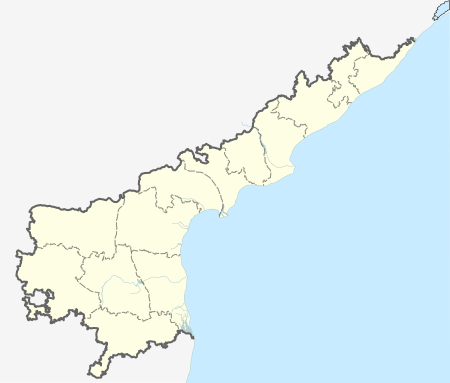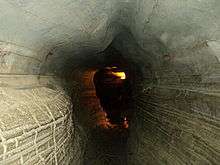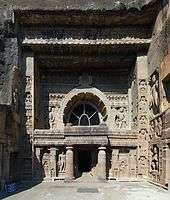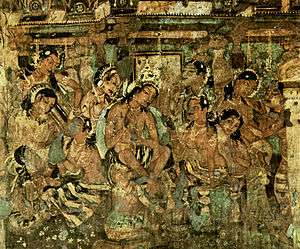Belum Caves


Belum Caves is the largest tourist cave in Indian subcontinent and the longest caves in plains of Indian Subcontinent, known for its stalactite and stalagmite formations. Belum Caves have long passages, spacious chambers, fresh water galleries and siphons. It is a natural underground cave formed by the constant flow of underground water. The caves reach its deepest point (150 feet from entrance level) at the point known as Pataalaganga.[1] In Telugu language, it is called బెల్లము గుహలు Belum Guhalu. Belum Caves has a length of 3229 metres, making it the second largest natural caves in Indian Subcontinent after Krem Liat Prah caves in Meghalaya.
It was brought to scientific attention in 1884 by a British surveyor Robert Bruce Foote, later in 1982-84, a team of German speleologists headed by H Daniel Gebauer conducted a detailed exploration of the caves. Thereafter in 1988, the state government declared them protected, and Andhra Pradesh Tourism Development Corporation (APTDC) developed the caves as a tourist attraction in February 2002. Today, 3.5 km of the cave has been successfully explored, though only 1.5 km is open to tourists.[1] There are 16 different pathways, including the main entrance and there are deposits of Quartz in the caves. The caves are formed in Black Limestone.
The site
Belum Caves are located at Belum Village in Kolimigundla Mandal of Kurnool District in State of Andhra Pradesh. Kolimigundla is situated 3 km from Belum Caves.[2]Belum Caves is 8 km drive from Petnikota village.
It is part of a larger complex of caves carved out of the limestone deposits in the Erramalai region. Other caves include Billasurgam caves, Sanyasula caves, Yaganti caves, Yerrajari caves, and Muchchatla Chintamanu caves (caves are called gavi in the local language).
Discovery
Even though the Belum Caves were known to the locals, the first records of Caves were mentioned in expedition report of the British geologist and archaeologist Robert Bruce Foote, in 1884. Thereafter, Belum Caves remained unnoticed for almost a century till a German team headed by Herbert Daniel Gebauer conducted detailed exploration of the caves in 1982 and 1983. The German expedition was assisted by the locals Mr Bacham. Chalapathi Reddy (retd. Deputy superintendent of police ), Mr Pothireddy Rama subba Reddy(retd.Headmaster), Mr Ramaswami Reddy, Mr Boyu Madduleti, Mr K. Padmanabhaiah, Mr K. Chinnaiah and Mr A. Sunkanna.[3]

- 4500 BC Remnants of vessels of that age were found in the caves.
- ???? occupied by Jains and Buddhists monks.
- 1884 existence of the caves recorded by the British geologist and archaeologist Mr Robert Bruce Foote.
- 1982 explored by the German Herbert Daniel Gebauer.
- 1983 explored by the German Herbert Daniel Gebauer.
- 1988 declared protected by the Government of Andhra Pradesh.
- 1999 development of the cave by Andhra Pradesh Tourism Development Corporation started.
- FEB-2002 cave opened to the public.
- JUL-2002 Musical chamber discovered.
- JAN 2013 A new cavernicolous Isopod species named Andhracoides gebaueri
Historical importance
Belum Caves are geologically and historically important caves. There are indications that Jains and Buddhists monks occupied these caves centuries ago. Many Buddhists relics were found inside the caves. These relics are now housed in Museum at Ananthapur.
Archaeological survey of India (ASI) also found remnants of vessels, etc. of pre-Buddhist era and has dated the remnants of vessels found in the caves to 4500 BC.[4]

Biological importance
A new and second Indian cavernicolous species of the genus Andhracoides was discovered from Pataalaganga chamber of Belum caves. The organisms named Andhracoides gebaueri in honor of the famous German caver Herbert Daniel Gebauer who mapped the complete Belum cave [5]
Development of Caves




The caves was being used to dump wastes of nearby places till 1988. The local people of nearby areas, notably Retired Additional Superintendent of Police M. Narayana Reddy, residents of Belum Village like (retd.DSP)Bacham. Chalapathi Reddy, (retd.Headmaster) Pothireddy Rama subba reddy , P.lakshmi devi ,B.Maheswara Reddy and (contractors) Basam Nageswara Reddy ,Pothireddy venkata subba reddy followed up Government of Andhra Pradesh to develop the caves as tourist attraction. Finally their almost two decade long efforts resulted in when Government of Andhra Pradesh declaring entire area to be protected zone. Finally in the year 1999, Andhra Pradesh Tourism Development Corporation took over the task of beautifying and maintaining the caves. APTDC sanctioned Rs.75,00,000.00 to develop the caves.[4]
The caves are now managed by Andhra Pradesh Tourism Development Corporation (APTDC). Andhra Pradesh Tourism Development Corporation (APTDC) has developed the pathways in around 2 km of the length of the caves, provided soft illumination and has created fresh-air-shafts in the caves. At many places inside the cave, APTDC has installed bridges, staircase, etc. for easy movement inside the cave. It has also created a canteen, washroom and toilet facilities near the entry point.
There is a giant Buddha Statue near a hillock near the Belum Caves. The area of cave known as "Meditation hall" was used by Buddhist Monks. The relics of Buddhist period were found here. These relics are now housed in museum at Ananthapur.
Main Sections of Belum Caves

- pillidwaram — pillidwaram means cats gate. It is a natural arch of stalactites formed in the shape of a lion’s head;
- Kotilingalu Chamber - This section contains stalactite formations which are akin to shiva lingams. This section has thousands of such stalactite giving it a surrealistic look. It has one huge pillar formed due to stalactite and stalagmite joining together.
- Patalaganga - It is a small perennial stream which disappears into the depths of the earth. This stream flows from the southeast to northwest. It disappears and is believed to be heading towards a well at the Belum village, located 2 km away from the caves.
- Saptasvarala Guha or Musical Chamber - Saptasvarala Guha means chamber of seven notes. The stalactite formations in this chamber reproduce musical sounds when these are struck with a wooden stick or knuckles. This section was opened to the public in 2006.[6]

- Dhyan Mandir or Meditation Hall - This section is near to the entrance. An interesting formation at Meditation hall looks like a bed with pillow to recline. The local legend has it that in ancient times many sages used to live here. This section was used by Buddhist Monks. Many relics of Buddhist period were found here which are now housed in museum at Ananthapur.
- Thousand Hoods - This section has amazing stalactite formations shaped like hood of Cobra. The stalactite formations on the ceiling looks as if thousands of cobras have opened their hoods.
- Banyan Tree Hall - This section has a huge pillar with stalactites hanging from the ceiling. This gives a look of Banyan Tree with its aerial roots when seen from below. The locals call it "Voodalamari" since it looks like a Banyan Tree with its aerial roots hanging from the branches.
- Mandapam - This is a huge area inside the cave with magnificent stalactite structures on the sides giving it a look of a hall with pillars.
-

Interiors
-

Ceiling of Hall of Thousand Hoods
-

Man striking stalactite formation to produce musical notes.
-

Passage inside the Caves
-

Visitors inside the Caves
Entrance to Caves
The tourists are charged an amount of Rs.50.00 for entrance. Foreign Tourists are charged Rs.300.00 per person for entrance. APTDC has installed electronic gates at entrance. After passing through the gates, one can reach the caves by a metal staircase installed by APTDC.
The entrance pit was originally smaller than what one sees today. It has been broadened as part of development of the caves to install the staircase to allow visitors to descend and ascend easily.
The entrance is like that of a Pit Cave. From the ground you can only see two pits side by side and third pit a little further away. After descending around 20 meters by the stairs from the entrance, the caves become horizontal. The first section one enters is called Gebauer Hall named after Speleologist Mr H. Daniel Gebauer, who had explored and mapped the caves in 1982-1983. The path to Gebauer Hall leads below the second opening, which lies next to the main entrance.
Awards to APTDC for Belum Caves
- In, 2003, APTDC won the prestigious "National Tourism Awards" instituted by Ministry of Tourism and Culture, Government of India, for its initiatives in developing and promoting Belum Caves.
- Belum caves was also adjudged the best destination award 2002 at the Tourism and Travel Fair held in Bangalore in 2002.[7]
Access
The nearest railhead to reach Belum Caves is Tadipatri ,30 kilometers away. There are daily trains from Delhi, Mumbai, Chennai, Hyderabad, Tirupati, Kanyakumari, Thiruvananthapuram, Coimbatore and Goa which halt at Tadipatri railway station. From Tadipatri, one can catch a bus to Belum Caves.
Distance from major cities/towns
- 301 km from Bangalore
- 365 km from Hyderabad
- 420 km from Chennai
- 106 km from Kurnool
- 85 km from Anantapur, Andhra Pradesh
- 165 km from Puttaparthi
- 68 km from Proddatur
- 30 km from Tadipatri
- 60 km from Nandyal
- 25 km from Banganapalle
- 34 km from koilkuntla
- 44 km from Jammalamadugu
- 135 km from Adoni
- 92 km from Guntakal
- 737 km from Visakhapatnam
- 76 km from Chilamkur
It is very near to Owk, and adjacent to Belum Village,
See also
References
- 1 2 "Underground adventure in Belum caves". Deccan Herald. January 27, 2008. Archived from the original on June 2, 2008.
- ↑ Reddy, K. Thimma (1976) Billasurgam: An Upper Palaeolithic Cave Site in South India
- ↑ The Hindu Business Line : Belum caves on the tourist map
- 1 2 Show Caves of India: Belum Caves
- ↑ new species
- ↑ Educationworldonline.net
- ↑ "Belum caves bag prestigious award". The Times Of India. January 18, 2003.
- A new species of Andhracoides Wilson and Ranga Reddy, 2011 (Isopoda: Hypsimetopidae) from Belum Cave, Andhra Pradesh, India, with a phylogenetic review of the family by George D. F. Wilson, Shabuddin Shaik and Yenumula Ranga Reddy Source: Journal of Crustacean Biology, Volume 35, Issue 2, pages 216 – 240 Publication Year : 2015, DOI: 10.1163/1937240X-00002333, ISSN 0278-0372, E-ISSN 1937-240X, Document Type: Research Article. http://booksandjournals.brillonline.com/content/journals/10.1163/1937240x-00002333
External links
| Wikivoyage has a travel guide for Belum Caves. |
| Wikimedia Commons has media related to Belum Caves. |
Coordinates: 15°06′09″N 78°06′41″E / 15.10250°N 78.11139°E
- www.BelumCaves.com Website'
- Deccan Herald - Underground adventure in Belum caves
- The Telegraph - Calcutta : Weekend
- cave-biology.org Cave biology (biospeleology) in India.
- Belum Caves collection Flickr'


